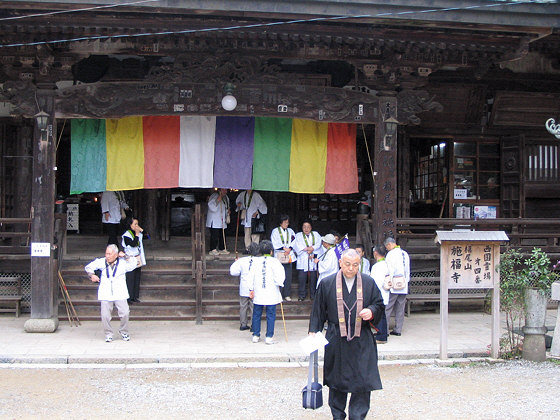Japanese Pilgrimages
These pages are a photographic guide to Japanese pilgrimages, particularly those of historic significance in the Kyoto and Nara areas of Western Japan.
Pilgrimages played an important part in the lives of Heian-era
Japanese aristocrats and later became popular with the common people.
The most famous temple circuit - which dates from Heian times - is the
Saigoku Kannon pilgrimage of 33
temples in Western Japan. Another well-known circuit is the 88-temple
pilgrimage dedicated to Kobo Daishi (Kukai) on the island of Shikoku.
And there are many more. A more recent circuit is the Kyoto Jusan Butsu, a
pilgrimage dedicated to the 13 sacred buddhas and bodhisattvas
(butsu) of the Shingon sect. Each temple enshrines one of these
butsu.
Temple circuits are known in Japanese as junrei. Before the
first circuit was created in the Heian period a number of temples were
popular as pilgrimages in their own right. Three of them - Kiyomizu-dera, Ishiyama-dera and Hase-dera - enshrined highly respected images of
Kannon and were favoured by aristocratic ladies of the time. Another,
forbidden to women, was the mountain-top temple complex of sacred Mount Koya in Wakayama.
These days, pilgrimages are mostly undertaken by retired Japanese over
the age of 60 with the aim of making merit for their next life. But
day-trippers and tourists visit pilgrimage temples too, especially the
picturesque ones and the ones with famous images. Typically, the
pilgrim will buy a nokyocho (pilgrim's book) at the first temple
and have it stamped and inscribed at each temple for 300 yen. Some
nokyochos are actually binders and the temple will simply slip in a
pre-inscribed page and add the date. These cost around 1000-1500
yen. Fold-out screens are available for 3000-5000 yen and some pilgrims
buy expensive wall-scrolls or white jackets to be inscribed. A pilgrim
is supposed to be buried with these records of his merit.
Pilgrimages
- Saigoku Kannon (Seigantoji, Kimiidera, Kokawadera, Makinoodera, Fujiidera, Tsubosakadera, Okadera, Hasedera, Nan'endo, Mimurotoji, Kami Daigoji, Iwamadera, Ishiyamadera, Miidera, Imakumano Kannonji, Kiyomizudera, Rokuharamitsuji, Rokkakudo, Kodo, Yoshiminedera, Anaoji, Sojiji, Katsuoji, Nakayamadera, Kiyomizudera Hyogo, Ichijoji, Engyoji, Nariaiji, Matsunoodera, Hogonji, Chomeiji, Kannonshoji, Kegonji)
- Saigoku Kannon - a personal account
- Kyoto Jusan Butsu (13 buddhas) (Chishakuin, Seiryoji, Reiunin, Daikomyoji, Daizenji, Sennyuji, Inabayakushiji, Senbon Shakado, Ninnaji, Hokongoin, Hokanji, Toji, Horinji)
- Nara Jusan Butsu (13 buddhas) - a personal account
- Rakuyo - Kannon pilgrimage in Kyoto
- Yakushi 49 - Yakushi pilgrimage in Western Japan
- Kumano Kodo - Pilgrimage to the three shrines of the ancient Kumano faith in Wakayama



